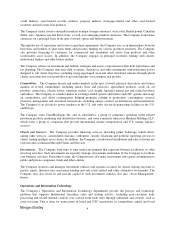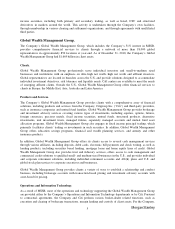Morgan Stanley 2010 Annual Report Download - page 20
Download and view the complete annual report
Please find page 20 of the 2010 Morgan Stanley annual report below. You can navigate through the pages in the report by either clicking on the pages listed below, or by using the keyword search tool below to find specific information within the annual report.
organization. It is Federal Reserve policy that bank holding companies should generally pay dividends on
common stock only out of income available from the past year, and only if prospective earnings retention is
consistent with the organization’s expected future needs and financial condition. It is also Federal Reserve policy
that bank holding companies should not maintain dividend levels that undermine the company’s ability to be a
source of strength to its banking subsidiaries. Under the Dodd-Frank Act, all companies that own or control an
insured depository institution will be required to serve as a source of strength to such institution; i.e., be able to
provide financial assistance to such institution when it experiences financial distress. Implementing regulations
must be issued by July 2012. Like the Federal Reserve policy currently in place, as well as periodic stress tests,
the new statutory source of strength requirement could influence the Company’s ability to pay dividends, or
require it to provide capital assistance to MSBNA or Morgan Stanley Private Bank, National Association (“MS
Private Bank”) (formerly Morgan Stanley Trust FSB) under circumstances under which the Company would not
otherwise decide to do so.
See also “—Capital Standards” above.
U.S. Bank Subsidiaries.
U.S. Banking Institutions. MSBNA, primarily a wholesale commercial bank, offers consumer lending and
commercial lending services in addition to deposit products. As an FDIC-insured national bank, MSBNA is
subject to supervision, regulation and examination by the OCC.
MS Private Bank conducts certain mortgage lending activities primarily for customers of its affiliate retail broker
Morgan Stanley Smith Barney LLC (“MSSB LLC”). MS Private Bank also offers certain deposit products. It
changed its charter to a national association on July 1, 2010, and is an FDIC-insured national bank whose
activities are subject to supervision, regulation and examination by the OCC.
Morgan Stanley Trust National Association is a non-depository national bank whose activities are limited to
fiduciary and custody activities, primarily personal trust and prime brokerage custody services. It is subject to
supervision, regulation and examination by the OCC. Morgan Stanley Trust National Association is not FDIC-
insured.
Prompt Corrective Action. The Federal Deposit Insurance Corporation Improvement Act of 1991 provides a
framework for regulation of depository institutions and their affiliates, including parent holding companies, by
their federal banking regulators. Among other things, it requires the relevant federal banking regulator to take
“prompt corrective action” with respect to a depository institution if that institution does not meet certain capital
adequacy standards. Current regulations generally apply only to insured banks and thrifts such as MSBNA or MS
Private Bank and not to their parent holding companies, such as Morgan Stanley. The Federal Reserve is,
however, subject to limitations, authorized to take appropriate action at the holding company level. In addition,
under the systemic risk regime, the Company will become subject to an early remediation protocol in the event of
financial distress. The Dodd-Frank Act also calls for a study on the effectiveness of, and improvements to, the
prompt corrective action regime, which may in the future result in substantial revisions to the prompt corrective
action framework.
Transactions with Affiliates. The Company’s U.S. subsidiary banks are subject to Sections 23A and 23B of the
Federal Reserve Act, which impose restrictions on any extensions of credit to, purchase of assets from, and
certain other transactions with, any affiliates. These restrictions include limits on the total amount of credit
exposure that they may have to any one affiliate and to all affiliates, as well as collateral requirements, and they
require all such transactions to be made on market terms. Under the Dodd-Frank Act, the affiliate transaction
limits will be substantially broadened. Implementing rulemaking is called for by July 2012. At that time, the
Company’s U.S. banking subsidiaries will also become subject to more onerous lending limits. Both reforms will
place limits on the Company’s U.S. banking subsidiaries’ ability to engage in derivatives, repurchase agreements
and securities lending transactions with other affiliates of the Company.
14
























